Superintendents — they’re just like you and me! They have homes and families and yards to tend. What’s more, no different than the rest of us, they often find fliers on their doorsteps from lawn-care companies, promising them lusher, greener turf.
What services, exactly, do these specialists offer? And are they worth it?
Jeremy Hreben, the superintendent at Indian Spring Country Club, in Marlton, N.J., has had plenty of lawn-care promos dropped at his front door and he has given them a fair amount of thought. “In general, the programs they offer are good,” Hreben says. “The only catch is that not everybody’s lawn needs everything.”
With the understanding that there are no one-size-fits-all answers, we asked Hreben to run through four standard lawn-care services along with his take on how critical they are.
1. De-thatching
Thatch is a layer of dead organic material that builds up on the soil surface. It isn’t all bad; thatch can help protect the roots of your grass from compaction. But too much of it can impede drainage and airflow while creating a welcoming environment for insects and disease.
Hence: de-thatching. A lot of lawn-care companies do this with a mechanical rake, which breaks up thatch and brings it to the surface to be cleared away. On the course, superintendents de-thatch by verti-cutting, a critical practice for keeping greens and fairways in good condition.
But how do you know if you need it in your yard?
One common sign of excessive thatch is soft and springy turf. “If I ever walk across lawn that feels almost like a trampoline, my first thought is, ‘they’ve got too much thatch,’” Hreben says.
A more conclusive test, though, is to punch a small hole in your lawn and pull out the plug. Thatch is easy to identify. It’s the layer of light-brownish stuff between the roots and the blades. “It’s got a texture like a sponge,” Hreben says. “If you squeeze it and then let go, it will bounce back into shape.”
How much of it is too much?
As a general rule, Hreben says, if the layer is an inch thick or thicker, de-thatching is good idea.
2. Herbicides
Any lawn-care company worth its salt will offer both pre- and post-emergent applications. As the names suggest, post-emergent herbicide kills established weeds, while pre-emergent herbicide stops weeds from growing in the first place. Where pre-emergent applications mainly target grassy weeds like crabgrass or goosegrass, post-emergents can be used on broadleaf weeds such as dandelions and clovers.
On the course, as a cost-saving and eco-conscious measure, superintendents mostly spot-treat weeds rather than broadcast-spraying the entire ground. In Hreben’s view, it’s the better way to go at home as well.
“Anytime you can reduce the amount of chemicals you’re using, that’s a good thing,” he says.
But spot-treating also takes more time and attention, so a big lawn-care company is likely to charge more for it, if they offer the service at all.
Another factor to consider is time of year. If you wait until late spring or early summer, there’s a good chance you’ll miss the window for a pre-emergent treatment, as grassy weeds have likely started growing already. What’s more, pre-emergent herbicides also prevent grass from growing, not just weed — something to consider if you’ve seeded or plan to seed your yard.
The best option? Hreben recommends getting your hands dirty and doing your own weeding.
If you’ve got kids, put them on them the job. It’s good for your yard, but that’s not all.
“It teaches them the value of hard work,” Hreben says.
3. Seeding
Hreben recently moved into a new home with a badly neglected lawn, so he just did a bunch of weeding. He also did some seeding, even though it wasn’t the ideal time of year.
Newly planted grass requires a lot of water, and if you’re irrigating those seedlings in the spring, you’re also encouraging the growth of crabgrass and other weeds. Fall is the better time to plant new grass, as there is less pressure from weeds and disease.
If you’ve got a few isolated bare spots in your yards, Hreben suggests mixing some good quality topsoil with seeds and using that. As for a large application of seeds in springtime, he doesn’t recommend it. Better to wait until early fall.
4. Soil tests
On the course, superintendents conduct sophisticated soil tests that are frequently beyond a layperson’s understanding. “If you start talking about them with people who aren’t in the industry, they’ll look at you like you’ve got three heads,” Hreben says.
Most soil tests at home are a different matter. “In my experience,” Hreben says, “they’re mainly testing for pH levels.”
Those levels themselves can have complex implications for the health of soil and roots and nutrient uptake. But delving into the nitty-gritty on that topic is probably more than the average homeowner needs to know. Generally, Hreben says, a pH level of 6.5-7.2 is ideal.
“Anything below, and I would consider adding lime,” he says.
What about getting the soil tested in the first place?
It doesn’t hurt to have the information, Hreben says.
But relatively inexpensive DIY soil kits are readily available, so if a lawn-care specialist is charging a hefty fee for the service, Hreben says he’d take a pass.
